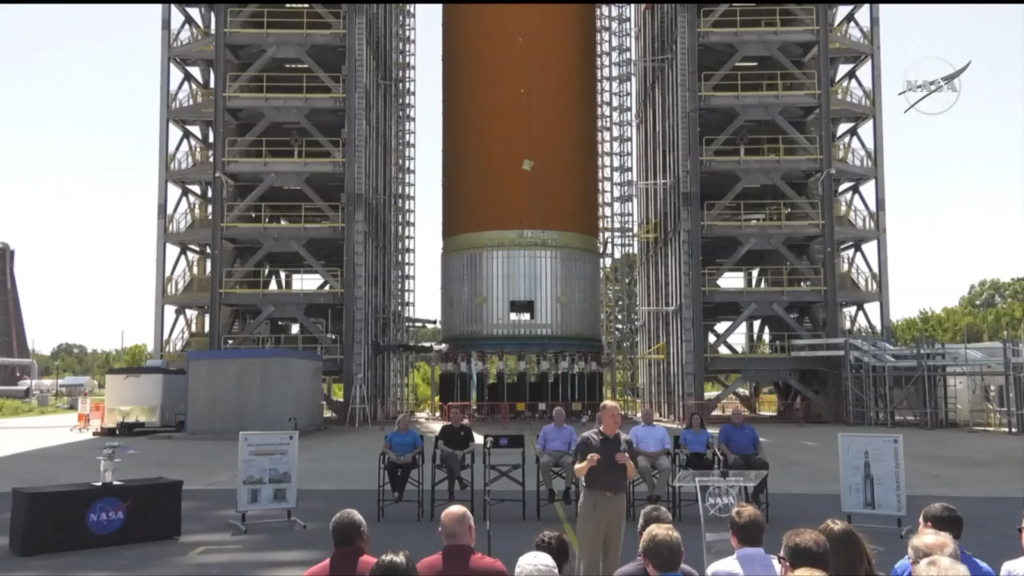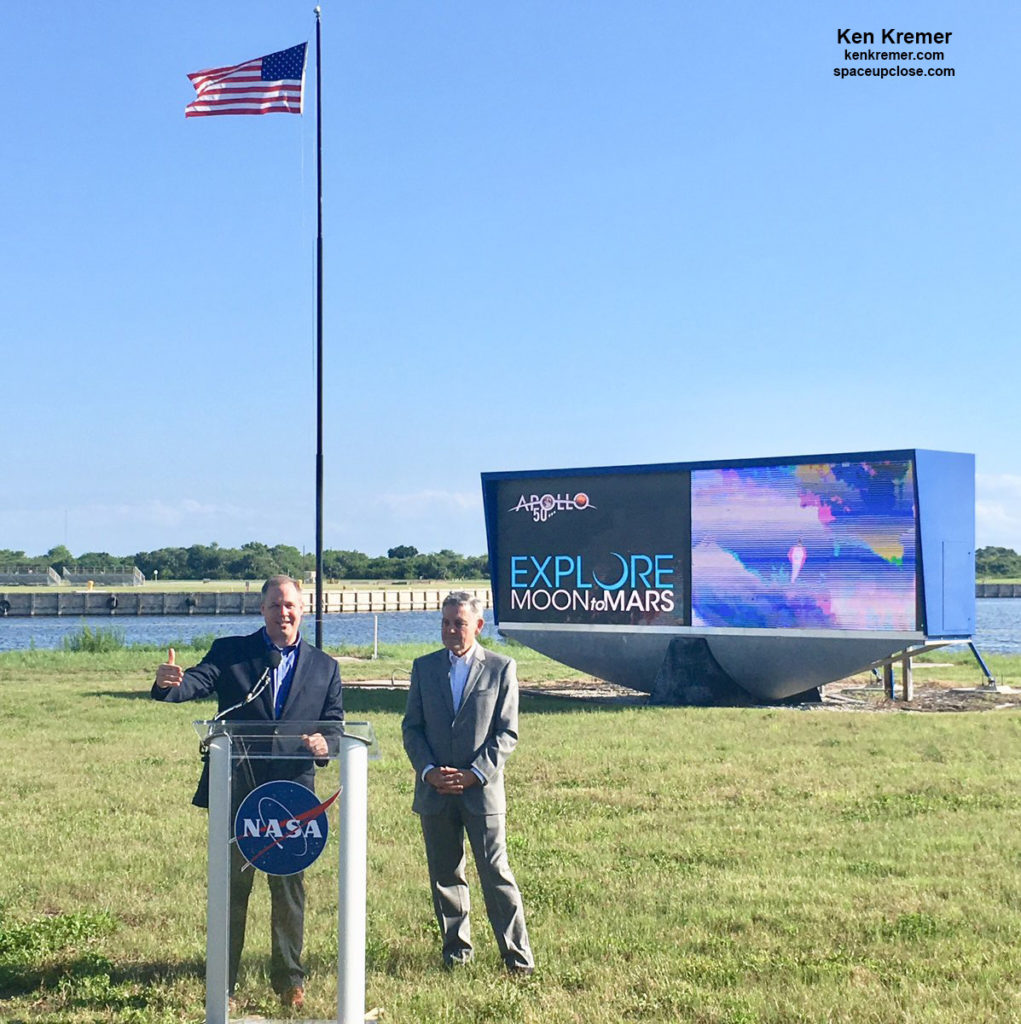Ken
Kremer — SpaceUpClose.com &
RocketSTEM – 18 Aug 2019
CAPE CANAVERAL, FL – NASA
Administrator Jim Bridenstine has selected NASA’s Marshall Space Flight Center
to lead the development of the Artemis human lunar lander for a return to the
Moon’s surface by 2024, during an announcement from Marshall broadcast live on
NASA TV on Aug 16, 2019.
Bridenstine made the announcement in front of
the 149-foot-tall Space Launch
System (SLS) rocket liquid hydrogen tank structural test article
currently being tested at Marshall.
NASA is already developing the SLS megarocket to
launch astronauts to the Moon aboard the Orion deep space capsule.
Orion will dock at the Gateway mini space
station in lunar orbit which is also under development by NASA.
But to get those astronauts to the lunar surface
requires development of a human lander – which had been the missing element and
was was the subject of the Aug. 16 announcement.
Back in March, Vice President
Mike Pence challenged NASA to accelerate plans to return to the Moon and announced
the Trump Administrations new goal of achieving an American lunar landing by
2024 at the south pole with the first woman and next man from NASA’s astronaut
corps.
That 2024 landing target
is four years earlier then NASA’s prior goal of 2028 and would take place on the Artemis-3 mission. The recently renamed program derives from
Artemis being the twin sister of Apollo – NASA’s original Moon landing program
begun by President Kennedy.
 |
|
Artists concept for NASA’s human return to
the Moon’s surface by 2024 under Project Artemis. Credit: NASA |
Here are
the details from NASA:
“NASA Administrator Jim Bridenstine was joined
Friday by U.S. Representatives Mo Brooks and Robert Aderholt of Alabama and
Scott DesJarlais of Tennessee at the agency’s Marshall Space Flight Center in
Huntsville, Alabama, to announce the center’s new role leading the agency’s Human Landing System Program
for its return to the Moon by 2024.
“Marshall Space Flight Center is the birthplace
of America’s space program. It was Marshall scientists and engineers who
designed, built, tested, and helped launch the giant Saturn V rocket that
carried astronauts on the Apollo missions to the Moon,” Brooks said. “Marshall
has unique capabilities and expertise not found at other NASA centers. I’m
pleased NASA has chosen Marshall to spearhead a key component of America’s
return to the Moon and usher in the Artemis
era. Thanks to Administrator Bridenstine for travelling here to share the great
news in person.”
Bridenstine discussed the announcement in front
of the 149-foot-tall Space Launch
System (SLS) rocket liquid hydrogen tank structural test article
currently being tested.
“We greatly appreciate the support shown here
today by our representatives in Congress for NASA’s Artemis program and
America’s return to the Moon, where we will prepare for our greatest feat for
humankind – putting astronauts on Mars,” Bridenstine said. “We focus on a ‘One
NASA’ integrated approach that uses the technical capabilities of many centers.
Marshall has the right combination of expertise and experience to accomplish
this critical piece of the mission.”
Informed by years of expertise in propulsion
systems integration and technology development, engineers at Marshall will work
with American companies to rapidly develop, integrate, and demonstrate a human
lunar landing system that can launch to the Gateway,
pick up astronauts and ferry them between the Gateway and the surface of the
Moon.
“Marshall Space Flight Center, and North
Alabama, have played a key role in every American human mission to space since
the days of Mercury 7. I am proud that Marshall has been selected to be the
lead for the landers program,” said Aderholt. “I am also very proud that
Marshall has designed and built the rocket system, the Space Launch System, which
will make missions to the Moon and Mars possible. We look forward to working
with our industry partners and our NASA partners from around the country.
“NASA’s Johnson Space Center in Houston, which
manages major NASA human spaceflight programs including the Gateway, Orion, Commercial Crew
and International Space Station,
will oversee all aspects related to preparing the landers and astronauts to
work together. Johnson also will manage all Artemis missions, beginning with Artemis 1,
the first integrated test of NASA’s deep space exploration systems.
The trip to Marshall came the day after
Bridenstine visited NASA’s Michoud Assembly
Facility in New Orleans, where he viewed progress on the SLS core
stage that will power NASA’s Artemis 1 lunar mission. With the start of testing
in June on the liquid hydrogen tank article, and the recent arrival of the
liquid oxygen tank at Marshall, which manages the SLS Program, NASA is more
than halfway through SLS structural testing.
“The Tennessee Valley, including Huntsville and
stretching across Middle Tennessee, is a dynamic, exciting region, home to
thousands of men and women – working at both public and private institutions –
who are leading the United States into the next age of space exploration,” said
DesJarlais. “As a member of the House Armed Services Committee, I am thrilled
to visit one of our country’s premier facilities, near Arnold Air Force Base
and others, developing the latest spaceflight technology. NASA’s Artemis
program will help our country to create another American Century. We can be
proud of our achievements, especially here at the Marshall Space Flight
Center.”
NASA recently issued a draft
solicitation and requested comments from American companies
interested in providing an integrated human landing system – a precursor to the
final solicitation targeted for release in the coming months. The agency’s
human lunar
exploration plans are based on a two-phase approach: the first
is focused on speed – landing on the Moon within five years, while the second
will establish a sustained human presence on and around the Moon by 2028. The
agency will use what we learn on the Moon to prepare for the next giant leap –
sending astronauts to Mars.
………..
Watch for Ken’s continuing onsite coverage of NASA, SpaceX, ULA,
Boeing, Lockheed Martin, Northrop Grumman and more space and mission reports
direct from the Kennedy Space Center, Cape Canaveral Air Force Station, Florida
and Wallops Flight Facility, Virginia.
Stay tuned here for Ken’s continuing Earth and Planetary science and human
spaceflight news: www.kenkremer.com
–www.spaceupclose.com – twitter @ken_kremer – email: ken at kenkremer.com
Dr. Kremer is a research scientist and journalist based in the KSC area, active
in outreach and interviewed regularly on TV and radio about space topics.
………….
Ken’s photos are for sale and he is available for lectures and outreach events
Ken’s upcoming outreach events:
Aug 30, 7 PM: Skyscrapers Inc
Astronomical Society, Seagrave Memorial
Observatory, 47 Peeptoad Road, North Scituate, Rhode Island
“Exploring Mars and the Search for life – 3D” – Learn all about NASA’s
Curiosity Mars rover illustrated with Ken’s custom created Mars rover panoramas
from Curiosity, Spriit and Opportunity and up close clean room and launch pad
views. Plus brief presentation from Space Shuttle seamstress Jean Wright. Free
and open to public.
Space/Rocket/Mars imagery for sale to support his outreach



